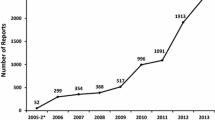Summary
Despite all its limitations, the spontaneous reporting system still forms the basis for drug safety assessments in the Federal Republic of Germany. Although there have been some promising attempts to standardise the methodology of detecting, analysing and evaluating adverse drug events (ADEs) in certain clinico-pharmacological institutes and psychiatric departments, the approaches have not been integrated and are used only locally. The only exception is the Freiburg Documentation Centre for Severe Skin Diseases, which is attempting comprehensive, country-wide documentation of toxic epidermal necrolysis (Lyell's syndrome) and Stevens-Johnson syndrome. We show that surveillance of 40% of all hospital beds would allow the acquisition of reliable data even on rare and serious AEs which could then be extrapolated in a statistically meaningful way. The medical societies in Germany have traditionally taken a leading role in establishing standards for the preclinical and clinical investigation of new drug compounds. We suggest that they also make it their task to define the framework for an intensified adverse events monitoring system, since it is the patient who ultimately benefits from a quantification of drug therapy risks.
Similar content being viewed by others
Abbreviations
- AE:
-
Adverse event
- ADR:
-
Adverse drug reaction
- BGA:
-
Bundesgesundheitsamt (Federal Health Authority)
- DDD:
-
Defined daily dose
References
Benichou C (1990) Criteria of drug-induced liver disorders. Report of an international consensus meeting. J Hepatol 11:272–276
Danan G, Benichou C (1990) Réunion internationale de consensus sur les définitions et les critères d'evaluation des atteintes hépatiques médicamenteuses (1). Abstract 36. First European Symposium of Pharmacovigilance. 12th Meeting on Pharmacovigilance, 29–30 October, Strasbourg
Faich GA (1989) Memorandum. Department of Health and Human Services Public Health Service, Food and Drug Administration, Center for Drug Evaluation and Research, April PMS News Quarterly, pp 1–6
Fink JL, Myers MJ, Palumbo FB (1978) Use of patient medication records: a three-state study. AMJ Pharm sc Support-Public-Health 150 (63): 81–88
Hasford J (1986) Methoden zur Erfassung unerwünschter Arzneimittelwirkungen. In: Dölle W et al. (Hrsg) Grundlagen der Arzneimitteltherapie. Bibliographisches Institut, Mannheim, S 281–287
Hasford J, Victor N (1987) Risk-benefit analyses of drugs: fundamental considerations and requirements from the point of view of the biometrician. Problems in the assessment of the combination of trimethoprim with sulfamethoxazole. Infection 15 [Suppl 5]:S236–S240
Helmchen H, Hippius B, Müller-Oerlinghausen B, Rüther E (1985) Arzneimittelüberwachung in der Psychiatric. Nervenarzt 56:12–18
Inman WHW (1980) The United Kingdom. In: Inman WHW (ed) Monitoring for drug safety. MTP Press, Lancaster, pp 9–48
Jick H (1977) The discovery of drug-induced illness. N Engl J Med 296:481–485
Jick H, Miettinen OS, Shapiro S, Lewis GP, Siskind V, Slone D (1970) Comprehensive drug surveillance. JAMA 213 (9):1455–1460
Kapp JF (1987) Vortrag: Welche Lehren hat die pharmazeutische Industrie aus dem Contergan-Unglück gezogen? BPI-Symposium: 25 Jahre Arzneimittelgesetz — Fortschritte der Arzneimittelsicherheit, 18. Mai 1987, Bonn
Kewitz H (1977) Erhebungen über die Arzneimitteltherapie in der Klinik. Verh Dtsch Ges Inn Med 83:1487–1502
Kreutz G (1990) Mitteilung: The principles and practice of pharmacoepidemiology. Conference 14.–17. October 1990, Strassburg
Porta MS, Hartzema AG (1987) The contribution of epidemiology to the study of drugs. Drug Intell Clin Pharm 21:741–746
Rawson NSB, Pearce GI, Inman WHW (1990) Prescriptionevent monitoring: methodology and recent progress. J ClinEpidemiol 43:509–522
Rossi AC, Hsu JP, Faich GA (1987) Ulcerogenicity of piroxicam: an analysis of spontaneous reported data. Br Med J 294:147–150
Schönhöfer PS, Wessely-Stickel B, Schulte-Sasse H, Werner W (1989) Flächendeckende Erfassung schwerer, potentiell lebensbedrohlicher unerwünschter Arzneimittelwirkungen. Verh Dtsch Ges Inn Med 95:687–690
Schöpf E, Stühmer A, Rzany B, Victor N, Zentgraf R, Kapp JF (1990) Toxische epidermale Nekrolyse und Stevens-Johnson-Syndrom. Epidemiologische Studie 1981 bis 1985. Dtsch Aerztebl 87 (46): A3641–3642
Schöpf E, Stühmer A, Rzany B, Victor N, Zentgraf R, Kapp JF (in press) Toxic epidermal necrolysis (TEN) and StevensJohnson Syndrome (SJS). An epidemiologic study conducted in West Germany. Arch Dermatol
Schwabe U, Paffrath D (1987) Arzneiverordnungsreport '87. Fischer, Stuttgart New York
Scott HD, Thacher-Renshaw A, Rosenbaum SE, Waters WJ, Green M, Andrews LG, Faich GA (1990) Physician reporting of adverse drug reations. Results of the Rhode Island Adverse Drug Reaction Reporting Project. JAMA 263:1785–1788
Solal-Celigny P, Benichou C, Boivin P, Castot A, Coulombel L, Danan G, Degos L, Evreux JC, Lagier G, Lavarenne J, Sonbrié C, Tchernia G, Tobelem G (1987) Critères d'imputation d'une cytopénie granuleuse ou plaquettaire à un médicament. Résultats de réunions de consensus. Nouv Rev Fr Hematol 29:265–270
Venning GR (1983) Identification of adverse reactions to new drugs. III: Alerting processes and early warning systems. Br Med J 286:458–460
Victor N (1990) Nutzen-Risiko-Bewertung von Arzneimitteln. Dtsch Aerztebl 87 (13): A1008–1019
Weber JCP (1984) Epidemiology of adverse reactions to nonsteroidal antiinflammatory drugs. In: Rainsford KD, Velo GP (eds) Advances in inflammation research 6, Raven Press, New York, pp 1–7
Weber E, Ding R, Gundert-Remy U, Harenberg J, von Kenne H, Spohr U, Walter E, Oh KU, Seidl G, Fritz U (1979) Verordnungsmuster einer Medizinischen Universitätsklinik. Klinikarzt 8:851–854
Author information
Authors and Affiliations
Rights and permissions
About this article
Cite this article
Kapp, J.F., Zentgraf, R., Widmer, A. et al. A need to intensify drug surveillance in Germany. Klin Wochenschr 69, 775–779 (1991). https://doi.org/10.1007/BF01744267
Received:
Revised:
Accepted:
Issue Date:
DOI: https://doi.org/10.1007/BF01744267




